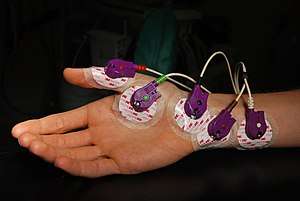Postoperative residual curarization
Postoperative residual curarization (PORC) or residual neuromuscular blockade (RNMB) is a residual paresis after emergence from general anesthesia that may occur with the use of neuromuscular-blocking drugs.[1][2] Today residual neuromuscular blockade is defined as a train of four ratio[3] of less than 0.9 when measuring the response to ulnar nerve stimulation at the adductor pollicis muscle using mechanomyography or electromyography.[4] A meta-analysis reported that the incidence of residual neuromuscular paralysis was 41% in patients receiving intermediate neuromuscular blocking agents during anaesthesia.[5] It is possible that > 100,000 patients annually in the USA alone, are at risk of adverse events associated with undetected residual neuromuscular blockade.[6] Neuromuscular function monitoring and the use of the appropriate dosage of sugammadex to reverse blockade produced by rocuronium can reduce the incidence of postoperative residual curarization.[7] In this study, with usual care group receiving reversal with neostigmine resulted in a residual blockade rate of 43%.
| Postoperative residual curarization | |
|---|---|
 | |
| Electromyographic monitoring at the adductor policies muscle. | |
| Specialty | Anesthesia |
_ratio_using_electromyography.jpg)
References
- Naguib M, Kopman AF, Ensor JE (2007). "Neuromuscular monitoring and postoperative residual curarisation: a meta-analysis". Br J Anaesth. 98 (3): 302–316. doi:10.1093/bja/ael386. PMID 17307778.
- Baillard C (2005). "Postoperative residual neuromuscular block: a survey of management". Br J Anaesth. 95 (5): 622–626. doi:10.1093/bja/aei240. PMID 16183681.
- Ortega, Rafael; Brull, Sorin J.; Prielipp, Richard; Gutierrez, Alexander; De La Cruz, Rossemary; Conley, Christopher M. (2018-01-25). "Monitoring Neuromuscular Function". New England Journal of Medicine. 378 (4): e6. doi:10.1056/nejmvcm1603741. ISSN 0028-4793. PMID 29365307.
- Naguib, M.; Brull, S. J.; Johnson, K. B. (2017). "Conceptual and technical insights into the basis of neuromuscular monitoring". Anaesthesia. 72 (S1): 16–37. doi:10.1111/anae.13738. ISSN 1365-2044. PMID 28044330.
- Naguib, M.; Kopman, A.F.; Ensor, J.E. (2007). "Neuromuscular monitoring and postoperative residual curarisation: a meta-analysis". British Journal of Anaesthesia. 98 (3): 302–316. doi:10.1093/bja/ael386. ISSN 0007-0912.
- Brull, Sorin J.; Naguib, Mohamed; Miller, Ronald D. (2008). "Residual Neuromuscular Block: Rediscovering the Obvious". Anesthesia & Analgesia. 107 (1): 11–14. doi:10.1213/ane.0b013e3181753266. ISSN 0003-2999.
- Brueckmann, B.; Sasaki, N.; Grobara, P.; Li, M.K.; Woo, T.; de Bie, J.; Maktabi, M.; Lee, J.; Kwo, J. (November 2015). "Effects of sugammadex on incidence of postoperative residual neuromuscular blockade: a randomized, controlled study". British Journal of Anaesthesia. 115 (5): 743–751. doi:10.1093/bja/aev104. ISSN 0007-0912.